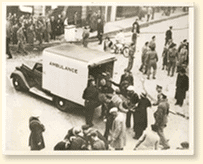

Casualties are placed in an ambulance by Air Raid Precautions workers, after a German bombing raid on a town in East Anglia, England, 1940.
Photo : Acme Newspictures Inc. |
The Invasion Threat to Britain and the Battle of Britain, 1940
Three weeks after the fall of France, Adolf Hitler issued orders
to prepare an invasion of Britain. The United States had not yet
come into the war, and Canada was Britain's sole major ally. After
Dunkirk ( see The German Invasion of Western Europe ), the 1st Canadian
was the only formation in Britain with enough equipment
to meet the German armies.
Before Hitler could launch his armies across the English Channel, he
first had to eliminate or neutralize the Royal Air Force (RAF). This
he could not do. In the Battle of Britain, July 10 to October 31,
1940, the first battle in world history to be fought wholly in the
air, both sides had roughly the same number of fighter aircraft. But
Britain was fighting for and over its own territory, and had the
advantages of radar and newer fighters. The Germans attacked ships
in the English Channel first, flew next against the airfields where
the RAF kept their fighters and then launched bomber raids aimed at
the heart of the British capital city, London.
No matter what, the Germans were unable to break the British fighter
defence. At the end of October, the German began to attack
London at night (the ""),
and Hitler postponed the
invasion indefinitely. No. 1 (Fighter) , later no. 401 ,
, flew Hawker Hurricanes in the Battle of Britain, losing three
of its pilots killed and ten wounded.
Related Newspaper Articles
English Articles
French Articles
-
Plutôt voir Londres en ruines et en cendres que le voir esclave' (M. Churchill)
Le Devoir, 15/07/1940
-
Projet d'invasion de l'Angleterre
Le Devoir, 16/07/1940
-
L'invasion de l'Angleterre sera des plus difficiles
Le Devoir, 18/07/1940
-
Deux grandes batailles aériennes au large de l'Angleterre
Le Devoir, 20/07/1940
-
Grande bataille dans la Manche
Le Devoir, 26/07/1940
-
Les Allemands ont maintenant recours à une sorte de guérilla aérienne
Le Devoir, 21/08/1940
-
La Grande-Bretagne reste sous la menace de l'invasion
Le Devoir, 03/09/1940
-
Les raids aériens de la nuit dernière
Le Devoir, 01/10/1940
-
L'abbaye de Westminster a subi des dommages
Le Devoir, 07/10/1940
-
La bataille de Grande-Bretagne
Le Devoir, 08/10/1940
-
Le bombardement de Londres de plus en plus intense
Le Devoir, 09/10/1940
-
4 ou 5 bombes à la minute
Le Devoir, 09/10/1940
-
Les aéroports anglais de la Manche sont encore en service
Le Devoir, 12/10/1940
-
Nouvelle tactique allemande
Le Devoir, 18/10/1940
-
La véritable situation en Angleterre selon un correspondant de l'A.P.
Le Devoir, 07/11/1940
-
Bombardement incendiaires à Londres
Le Devoir, 16/01/1941
-
La bataille de Grande-Bretagne. On prévoit la plus formidable attaque de l'histoire
Le Devoir, 25/01/1941
-
Londres subit le plus violent bombarfement depuis le début de l'année
Le Devoir, 20/03/1941
-
La guerre aérienne. Escadrilles anglaises et allemandes aux prises aujourd'hui au-dessus de la Grande-Bretagne
Le Devoir, 07/05/1941
-
La bataille de Grande-Bretagne
Le Devoir, 10/21/1943
|